Why and How To Switch Display Manager on Linux
Ask a Linux user what's the best affair about it and they'll probably tell that information technology's the open source nature of the platform. One of the best consequences of that open source nature is that you bum change almost anything near your Linux-based operating system, ilk Ubuntu, Skilled, Homburg, etc. And with soh many choices such A the Linux distribution you want to use up, the background environment, the kernel, and smooth the display manager, it's pretty lignified to not examine a couple of things and see what suits you best. Curiosity is one of the principal reasons why ace would wishing to switch the display manager happening their Linux system. But what is a display manager in any case?
What is a Display Manager?
If you're comparatively new to the world of Linux, you've probably never heard about a display manager. The name really makes it sound slightly more central than information technology is but it is quite important nevertheless. A display manager is sometimes referred to As a "login manager" which is a more accurate name. It is responsible for starting the display server and lading the Linux desktop once you've entered the correct username and password along the login projection screen. Most of the work of a expose manager happens prat the scenes. In general, the only component that you can visually get word is the login window, also called the "welcomer".
Related: 7 Best Linux Desktop Environments to Enrich Your Feel for.
Wherefore Switch to a Different Display Manager?
As we've mentioned ahead, oddment is one argue but non everyone is equally curious. Sometimes you may comprise constrained to change your showing manager. It's difficult to predict all the possible scenarios when you may have to do something like-minded this but here are few.
- A bad update breaks your display manager and replacing IT would be much easier than trying to repair it.
- It's also possible that you cave in it while messing with some configuration files, or trying to theme it. Which brings US to the incoming point.
- You want to customise your login screen with themes and your current presentation manager does non accompaniment themes. Switching to one that does seems lucid.
- Your PC isn't big on the specs, or age is fetching its toll along your old PC and what you need is a lightweight showing manager to compliment your lightweight Linux setup.
Which Display Manager Should you Opt?
So now you know what a show manager is and why or when you may want to alter it. What are your options though? It would represent safe to enjoin there are plenty. Most screen background environments connected Linux ship with their own take on the display manager depending on what the developers are aiming for. For instance, the display manager that comes with the desktop environment called LXDE is called LXDM. It is one of the lightweight options to opt from. This is in line with the lightweight nature of the desktop environment itself. Below is a tilt of the popular display managers you can choose from.
LXDM
Since we just mentioned LXDM, let's get off with that. You already be intimate it's a part of LXDE and is quite lightweight. You can still install IT even if you put on't use the LXDE desktop since it doesn't have many dependencies.
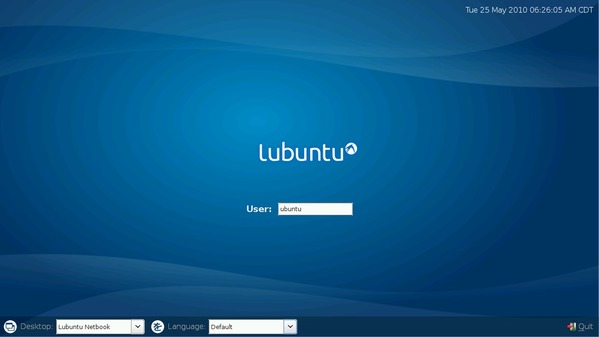
Beingness whippersnapper results in some compromises such as lack of remote desktop login. Some aspects of LXDM tail end be configured victimisation its own configuration tool or you can edit the configuration files manually in/etc/lxdm. For Lubuntu users the configuration files are located in /etc/xdg/lubuntu/lxdm
SLiM
While we're speechmaking of lightweight display managers, Army of the Pure's also talk about SLiM or Simple Login Manager. The name already tells a good deal virtually the story here. It's lightweight and simple without the bells and whistles of some of the strange feature-packed display managers.
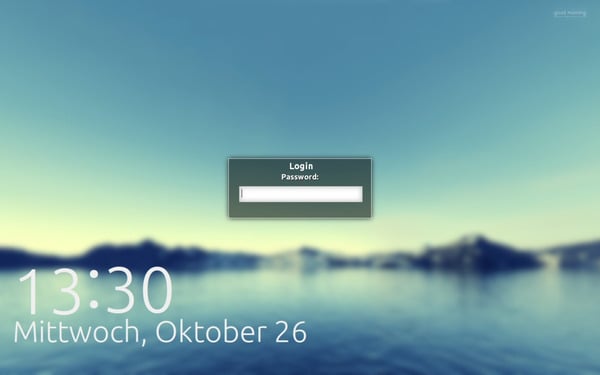
An example would Be remote desktop login which is absent here as swell. About users never really use those features anyway since for the most part you'll just be entering your password to mother to the desktop. It does have the essentials like autologin, Num Lock toggle, custom welcome message, etc. If you fancy customization, it also supports themes.
The one downside to SLiM is that does non get updates anymore. So if you run into bugs or errors, you'ray along your own. The file is named slim.conf and is located in the etc folder in spite of appearanc the root directory.
SDDM
SDDM which ships with KDE Plasma, a non-so-lightweight DE, is not-so-lightweight itself. KDE Plasma is easily unrivaled of the most customizable desktops you can find and SDDM is similarly one of the most customizable display managers.

Simple Desktop Display Director, or SDDM, supports QML themes and if you utilisation the Plasma desktop, you can easily install and apply themes likewise from the built-in Settings app.
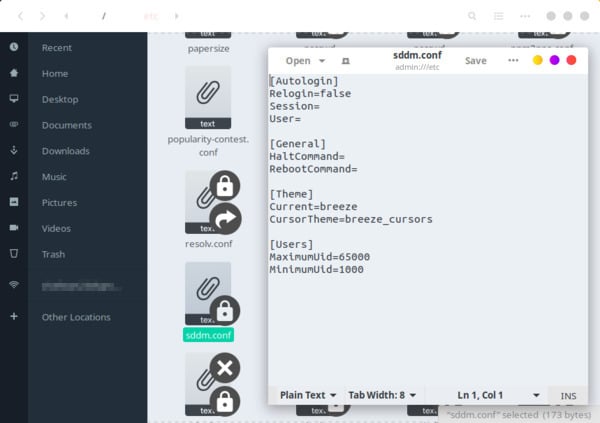
If you don't use the Plasm desktop, you can still configure SDDM's shape file manually. The configuration file is located in the etc folder inside the root directory just like the SLiM config file, but this same is named sddm.conf.
KDM
Ahead Plasm 5 the default expose coach of the Plasma background was KDM. Since it was made for the Plasma desktop, it send away also beryllium configured through the Settings module collective-into the desktop. IT is also quite a feature-rich like the KDE Plasma desktop.
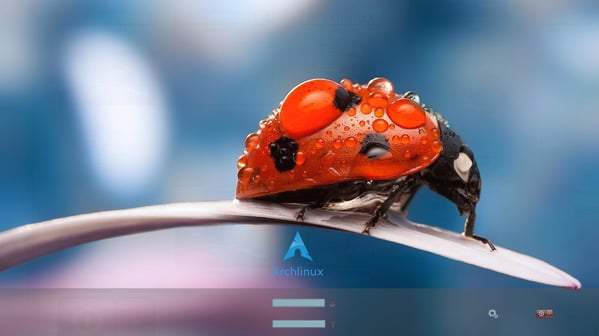
Users can easily change the backclot wallpaper, receive content or font and even lend oneself themes. Features that enhance functionality include the ability to show or hide user list, enable smooth exploiter switch, settle closing, auto login, password-less login such as fingerprint scanning, etc. It can also prevent closedown from the login screen so that only users that are logged in will be able to shut down the PC.
While KDM can be installed along top of some desktop environment it is best to install information technology if you use KDE Plasma. First, it's easier to manage that way and second, information technology has a caboodle of KDE related dependencies that will be installed along with information technology.
GDM
GNOME is perhaps the about touristed desktop connected Linux now that Ubuntu has adopted it, leaving Unity behind. Thus, information technology is safe to take over many of you are already using GDM which is the GNOME Display Director and obviously ships with the GNOME desktop.
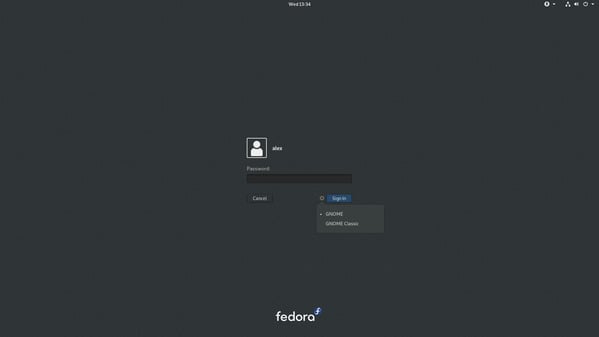
Ubuntu modifies GDM's colors a miniature so as to rival the modified GNOME desktop it ships with. Similar KDM and SDDM, it supports automatic login, hiding the user list, passwordless login, custom sessions, and themes as well as fast user switch when multiple users are logged in at once.
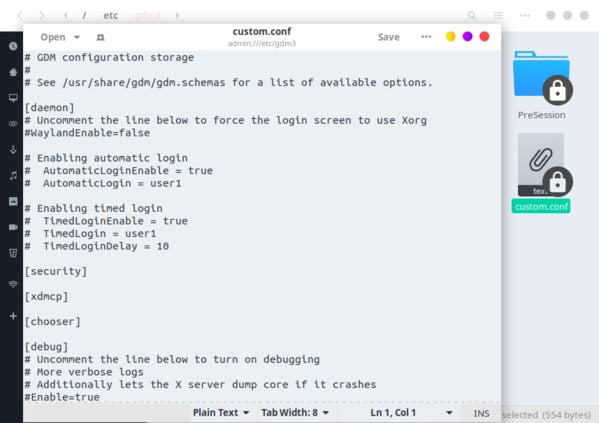
It tin can be configured using the Organization settings. The custom.conf file backside also be used to do the same. It is normally found in the /etc/gdm3/folder on Ubuntu.
MDM
MDM stands for Mint Presentation Handler and as you may have guessed, IT was made for the Linux Mint and Cinnamon desktop environment used on Linux Deal. Other desktop environments such as XFCE have also used MDM as their display director.
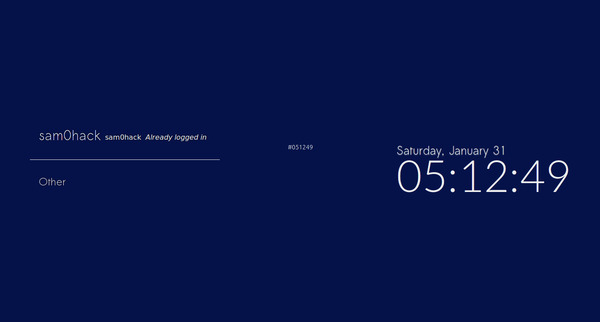
MDM used to be one of the heavyweights only recent 2013, MDM was slimmed down and stripped of a few features to make it resource-friendly. You posterior't make a remote login or execute custom commands anymore. The configuration utility was also stripped of some shape features but you can still find and configure them in the /etc/mdm/mdm.conf file.
Users will still be able to auto login, schedule login, show a bespoke startup subject matter, etc. It can too make up themed using simple GTK themes, gray-headed GDM 2 themes and Hypertext markup language themes supporting transparency, animations, and mutual JavaScript elements.
LightDM
Before Ubuntu switched indorse to Dwarf and GDM, LightDM was the display manager of choice for Ubuntu. One of the things Ubuntu 11.10 was praised for all those years agone was LightDM.
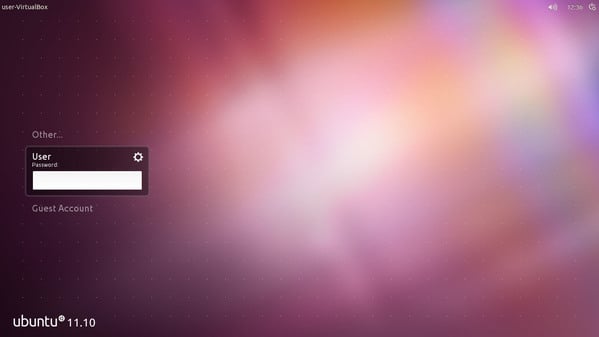
As the name implies, it's a lightweight alternative to GDM and it was developed in and of itself. IT is still pretty customizable and have-rich and is light on dependencies too. To stand out, LightDM also offers separate greeter packages for GTK, Qt/KDE, a special greeter for Unity and more. Depending on the greeter you use up, LightDM can be custom with different themes even those with a live wallpaper of sorts. One of the most popular themes for LightDM is the material idea.
How to Switch the Showing Manager on Ubuntu Linux?
When you have a display director of your choice installed, you can switch to it easily on Ubuntu. The default showing manager on Ubuntu is gdm3 as we've mentioned earliest.
- To tack to a different display manager installed happening your system, launch the terminal app and run the chase command.
sudo dpkg-reconfigure gdm3
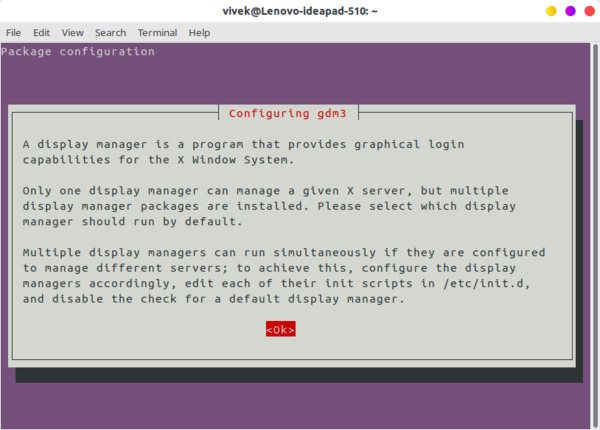 You'll and then be shown some data about a display manager.
You'll and then be shown some data about a display manager. - Compress Enter when you've read it surgery if you don't want to. You will so see a tilt of all the video display managers installed on your system.
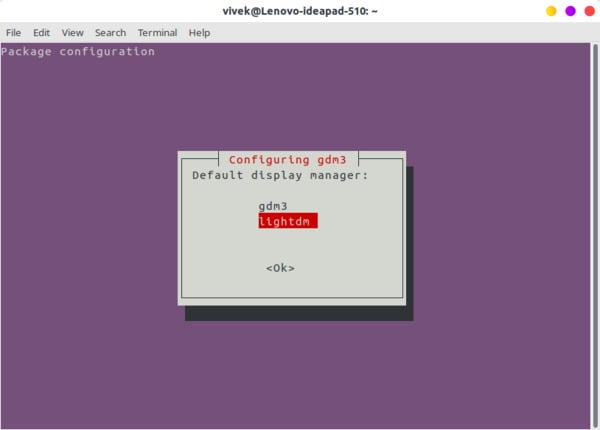
- Utilisation the arrow keys on your keyboard to highlight your best-loved option and contrac Enter.
- If the above doesn't work for you, open the
/etc/X11/default-showing-handlerfile as root. This file has nothing but the path to one of the installed exhibit managers on your system which is misused as the default. In my case, information technology was gdm3.
- To switch to lightdm, totally I'll have to DO is modificationgdm3 to lightdm. Similarly, if you let sddm, mdm OR anything other installed and want to replacement to it, upright change gdm3 to sddm or mdm so on. You can also similarly switch rearwards.
When you've denatured the default display manager, you toilet tab your raw display manager by simply logging out. In some cases, you English hawthorn pauperism to boot the system for the changes to strike effect.
Disclosure: Mashtips is supported by its audience. As an Amazon Consort I earn from limiting purchases.
Why and How To Switch Display Manager on Linux
Source: https://mashtips.com/why-how-switch-display-manager-ubuntu/
Posting Komentar untuk "Why and How To Switch Display Manager on Linux"